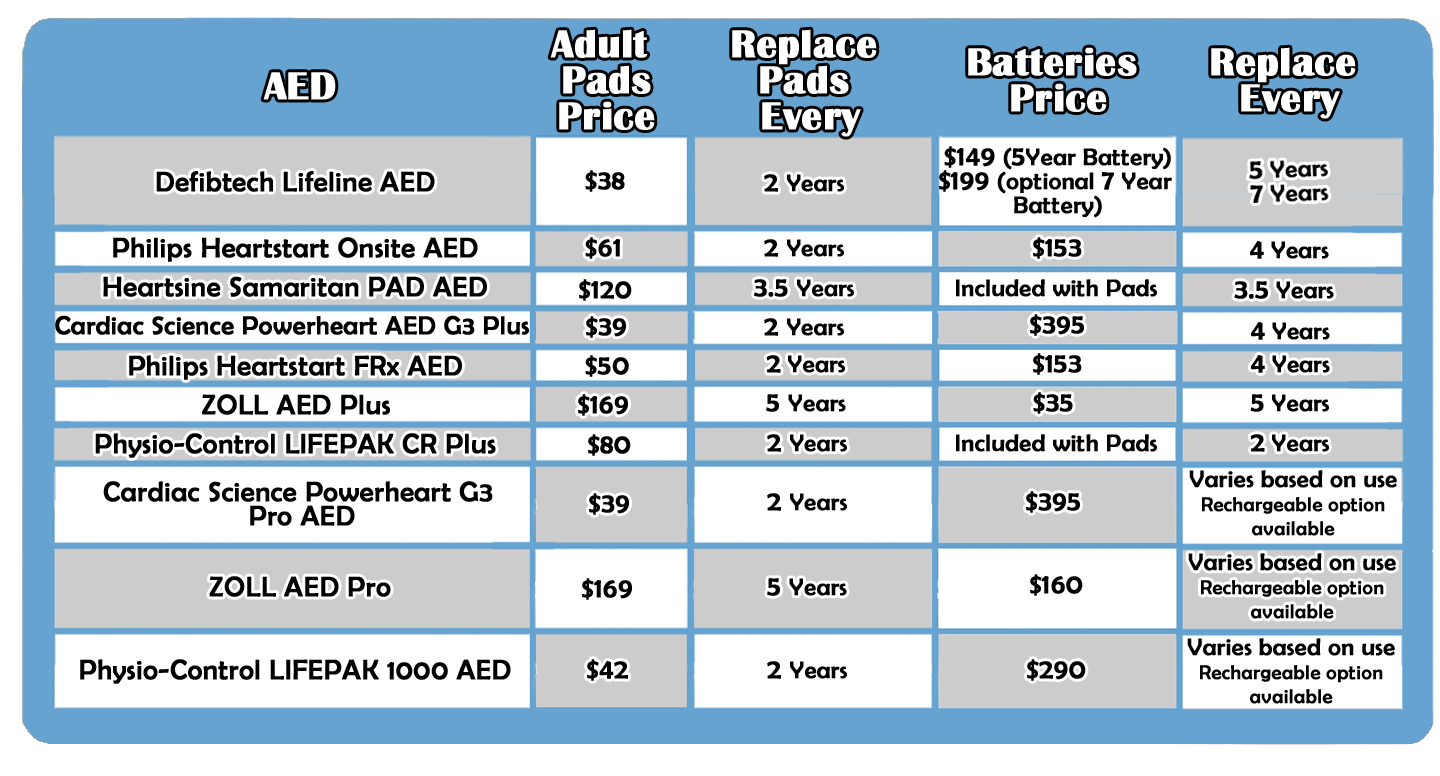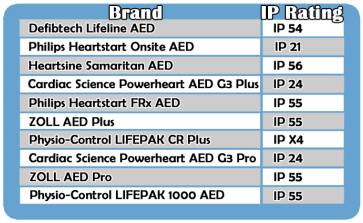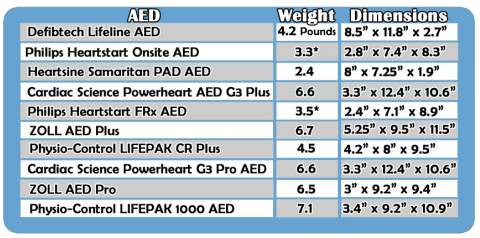|
How do I choose which AED is best for me?
First off, we would like to congratulate you for making the important commitment to looking into the idea of purchasing a life saving device. A question we get quite frequently is "which AED is the best?". This is a difficult question for us to answer and there is not one AED that saves more lives than another. All AED's save lives, all AED's we sell have been approved and cleared by the Food and Drug Administration, FDA, all AED's are good. Whatever AED you choose, we commend you. There are differences in AED price, water resistance, CPR help, overall operation, features, display options, size, warranty, the way it is upgraded, ownership costs and included accessories. We will address most of these differences. Keep in mind, we do not recommend one device over another and your choice of AED is going to depend on your budget, the environment in which the AED is to be placed, comfort level of responders and other factors. If you have any additional questions about AED's, just give us a call and we love to talk AED's.
Price
Pricing
has decreased significantly since AED's first became available in the
mid 1990's when they were anywhere from $3,000 to $5,000. The average
AED today ranges in price from around $1200 to the high end of about
$3000, for professional AED versions.
When looking at AED product costs, look at the total cost and what is included with that, in the way of accessories, long term replacement costs and replacement frequency of the accessories. It is
important to determine your budget early on and be sure to include any
accessories such as:
pediatric AED pads, spare AED pads (optional), spare batteries (optional),
AED cabinet
or wall bracket (optional), CPR and AED training (required), Medical
Direction (required in some states)
, wages for training sessions, long
term costs (replacement pads and batteries, refresher training).
Pricing is based on MAP pricing including applicable rebates as of 11/13/2009

Dates based on manufactures specifications and pricing based on MAP and/or MSRP pricing as of 11/13/2009
Many ask the question "why is there such a difference in prices on pads, aren't all pads the same?" The answer is yes and no. There have been a lot of advancements in AED pads throughout the years and we'll highlight a few that we think are pretty cool. There are 2 broad types of AED pads: Adult and Pediatric. All AED's sold on AEDUniverse.com do have pediatric pad compatibility (with pediatric pads purchased separately). Pediatric pads are typically more expensive than adult pads. Pediatric AED pads are used on children less than 8 years old or less than 55 pounds. Pediatric pads are a good idea if you come in to contact with children on a regular basis. Although, if you are a machine shop with 30 middle aged men, then pediatric pads may not matter. The Philips FRx has a unique child/infant key (sold separately) which when inserted into the AED allows you to use the adult pads on pediatrics. The advantage is you only buy Adult pads every two years and with the optional key you can use the same pads for both Adults and Children. If you need pediatric options then this maybe a cost savings over time. The Heartsine Samaritan PAD AED features a pad/battery combo with a 3.5 year life. The advantage being only one date to monitor and very easy to change. The ZOLL AED Plus has the option of CPR-D Adult pads which is a 1-piece pad. Pad placement is simplified and the pad features a CPR sensor to coach your CPR compressions and assure you are going deep enough, if not, it will tell you to "push harder". The ZOLL CPR-D Adult pads also carry a 5 year shelf life (the longest in the industry). The ZOLL CPR-D pads are more expensive at replacement time, but it requires less changes and evens out over time.
Why do pads expire? You may ask... AED pads are comprised of tin and an adhesive gel which allows the pads to stick on the victims chest. Over time the tin will eat away at the gel and the gel will loose it's adhesive properties and turn brown. You should follow the manufactures expiration dates to assure your AED equipment is ready when you need it.
Batteries
All batteries are the same.... or are they? There are differences among AED batteries and we'll highlight a few differences. Cardiac Science AED's features an Intellisense lithium battery and has a 4 year operational replacement guarantee. The batteries have an internal chip which records daily self-test data and has a expected life of 4 years from installation. The Defibtech Lifeline AED's are available with a 5 or 7 year battery option. The Defibtech battery is easy to install. The Defibtech battery is supplied with a 9 volt lithium battery that should be replaced annually. The Defibtech 9 volt lithium battery operates all the self test functions of the device. The battery on the Heartsine Samaritan PAD AED is incorporated with the pads and features a 3.5 year life (from the date of manufacture), only one date to remember and installs easily. Philips Heartstart Onsite and FRx AED's use a 4 year lithium battery (from the date of install), the battery installs very easily into the back of the unit. Philips Heartstart Onsite and FRx AED's have the option of an aviation battery for use on aircraft. Physio-Control LIFEPAK CR Plus AED's utilize a charge pack battery that has a 2 year life from the install date. Easy to install and is changed at the same time as the pads. The ZOLL AED Plus utilizes Duracell type 123 batteries, 10 of them to power the ZOLL AED Plus. Duracell batteries...... ? You ask. Well when you open some of the other proprietary AED battery packs there also utilize Duracell batteries and just charge you more for them. Advantage is that you can pick these batteries up at most retail stores and feature a 5 year life in the AED. The LIFEPAK 1000, ZOLL AED Pro and Cardiac Science Powerheart G3 pro AED's feature rechargeable battery options which usually only makes sense for EMS and professional rescuers. Shop for AED Batteries.
Water Resistance
Water resistance? Why does it matter? It may or may not matter. If you intend to use the AED indoors, work primarily in a dry clean environment and don't foresee the AED getting into the elements, skip this section. However if you want your AED to be used primarily outdoors, marine applications, work in dirty or even disgusting environments or you just don't know? You may want to read on. AED's are rated an IP rating which is "International Protection Rating" or "Ingress Protection Rating. The first digit in the rating indicates the level of protection against solid particles such as dirt, dust or other gunk (rated 0-6, 6 being the best protected). The second digit indicates the protection from water (rated 0-8, 8 being the best protected). If one of the digits is an "X" this means that the AED has not been tested for this or that a rating has not been made for that type of protection. To learn more about what all the numbers mean. click here.
The highest IP rated AED's are the Philips FRx, Defibech Lifeline, Defibtech View, ZOLL AED Plus, Heartsine Samaritan and for the Pro AED's they are the Physio-Control LIFEPAK 1000, Philips FR3 and ZOLL AED Pro units.
Please note that IP rating has nothing to do with the AED's ability to withstand a drop or it's overall ruggedness.

CPR Help
CPR is still an important role in the chain of survival even with the widespread deployment of AED's, in fact CPR is indicated 10 out of 10 times during sudden cardiac arrest whereas some studies show that defibrillation is only indicated about 6 or 7 out of 10 times or about 60% to 70%. CPR is important. Many manufactures are developing and many have implemented CPR help in to the AED's on the market today. The ZOLL AED Plus and Pro units features a built in CPR sensor in the CPR-D pads that provides feedback on the depth of compression's and can tell you to push harder if you are not achieving the recommended compression depth of 1-1/2 to 2" for adults. The ZOLL AED Plus also has a built in metronome that helps you maintain the recommended rate of 100 compression's per minute. The Philips Onsite and Philips FRx AED has a help button or "I" button that can be activated to assist with the rate compression's, it provides clear voice prompts and instructs the user how to deliver compression's and also has a metronome that can assist with maintaining the appropriate rate of compression's. The new Lifeline View from Defibtech features real time video display that not only helps you thru audio prompts but has a video screen to show you exactly what to do using full color video. The Cardiac Science Powerheart G3 Plus has metronome features and rescue coaching. All AED's will advise you when to do CPR and very soon all AED's will come around with additional and enhanced CPR help features. Upgrades to the Defibtech Lifeline now also include metronome features.
Display
To display or not to display? That may or may not be the question. In general a visual display screen probably makes no difference in overall use. Some AED's have display screens that show text on a screen on what the audio prompts are telling you and some AED's offer flashing lights that correspond to pre-printed text prompts or graphics and some just have audio (voice) prompts only. Display screens may or may not be an important purchasing factor, unless you work in a very noisy environment where you will not be able to hear the voice prompts thru the AED's speaker or the person using the AED is hearing impaired. The newest AED the Lifeline View from Defibtech features the best in visual display with full color animation that displays on the screen showing the users what to do next. The Cardiac Science Powerheart G3 Plus and G3 Pro, ZOLL AED Plus, ZOLL AED Pro and Physio-Control LIFEPAK 1000 AED all feature text displays. The Defibtech Lifeline AED, Philips Onsite, Philips FRx and Heartsine Samaritan AED all feature graphical pictures and flashing lights to indicate steps. The ZOLL AED Plus, ZOLL AED Pro, Cardiac Science G3 Pro and LIFEPAK 1000 offer optional ECG display, for most that information is not helpful but it maybe a great option for EMS, professional rescuers, doctors offices or dental offices. Is it important? Maybe, but maybe not? You decide.
Size
Size may or may not be a factor when deciding which AED to purchase. If you intend on your AED hanging in the AED cabinet in your office collecting dust, then maybe it doesn't matter. If you are constantly packing your AED around in a rescue pack or to football games, then maybe size is important.

* Weight includes case and battery
EMS Compatibility
A comment and myth we hear frequently is "I have to get the same defibrillator brand as my fire department for compatibility", We have yet to see any data that shows any clinical advantages or any significant time savings by deploying an AED that integrates with EMS devices. The reality is that when EMS arrives they are going to peel your AED pads off and apply their own pads (compatible or not) in the same amount of time (if not less) than the amount it time it would have taken to unplug the pads from the AED and plug in the their monitor/defibrillator. If you are convinced that compatibility is important, there are adapters that can work with most AED's to make the pads connector plug in to other units.
Training Compatibility
If you are going to get CPR and AED training from an outside company, don't worry about this section. If you are planning to do your CPR/AED training in-house or you are an instructor, you may want to pay attention because there are some differences in AED's for use in training. Some live AED's can be made to be used for training purposes and some AED's require you to purchase a stand alone training unit. A live Defibtech Lifeline AED can be easily converted to a training device by simply replacing the AED's live battery with a training battery and plugging in training pads. The Defibtech Lifeline View can be using in training mode on the live unit. The Philips Heartstart AED's can be converted to a training AED by simply applying training pads to the live unit. Keep in mind that why this sounds like a great feature there are pros and cons to these methods. A pro is that you don't have to by an additional training AED and typically the up front costs could be a little less. However, on the down side the live AED is subject to more wear and tear and more opportunities for damage to occur while it is being used for training. Secondly, while training you do not have a fully operational AED available in case of emergency and with the Philips AED's used for training, you will deplete your AED battery while training. May or may not be cost effective in the long run. Both the Philips and Defibtech AED's also have standalone AED trainer options.
Warranty
The standard factory warranty in the industry is 5 years for the AED's themselves (not including accessories). The Cardiac Science and Heartsine Samaritan AED's now come with a 7 year warranty on the device. Medtronic Physio-Control announced in February 2010 that all Physio-Control LIFEPAK CR Plus AED's will now come with an 8 year warranty. Philips AED's come standard with a 8 year warranty (devices sold after 12-1-2011) and allows customers to buy an extended 2 year warranty at anytime during the initial 8 year warranty. ZOLL AED's come with a 5 year warranty and an additional 2 year warranty once the AED has been registered with ZOLL (7 year warranty). Accessory warranties vary tremendously among manufactures and based on are based on the accessory. Cardiac Science has a 4 year unconditional replacement warranty on selected AED batteries.
Upgrades
It seems like the CPR and AED guidelines are changing all the time. One thing that is important to know is how is my AED upgraded? Can I do it myself or do I have to send it in? There are a few different ways to upgrade AED's and this does vary by model of AED. The ZOLL AED Plus can be upgraded easily via an InfraRed or IRDA which is located on the side of the AED. To upgrade the ZOLL AED Plus you would need a USB IRDA adapter which plugs into your computer and allows you to transmit software to the AED and preform upgrades or software corrections. In general most AED's have similar methods of making changes to the AED without sending the AED to the manufacture. The Defibtech Lifeline and Lifeline View AED's feature a SD card slot for making these changes very easily. Cardiac Science AED's all come standard with the required components (not necessarily software) for making software changes. The same components required to upgrade the AED can allow you to download a AED event which gets stored in the AED while it is being used in a rescue. Typically you would need to have the event review software which is usually available free via download. Check the AED resources sections of AEDUniverse.com for event review software. For more information on AED Upgrades
Conclusion
Which AED do we think is best? All AED's are good. Where are you going to be using it? What is the environment that the AED will be used in? What features are important to you? Some AED distributors believe that the best way to sell their AED is to "trash talk" the other manufactures. We believe that you should look at all the features of each device and determine which are important to you. ALL AED's save lives. Good Luck in your search. For more information on AED's give us a call at (866)517-8243 and we'll be happy to assist you.
|